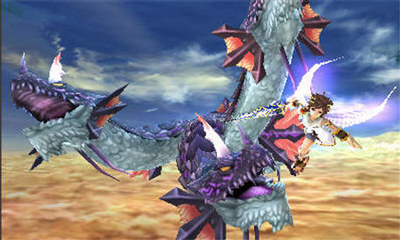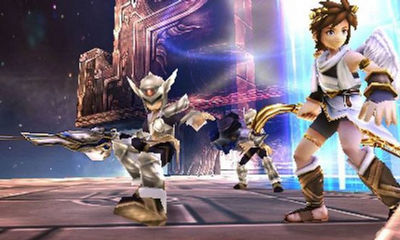. | 25 years ago, the NES game Kid Icarus was released. Often called the "sister game" of the original Metroid, it never matched its sibling's popularity. But now Kid Icarus is back in Kid Icarus: Uprising for the 3DS, where he must defend the heavens and the earth from Medusa and the forces of the Underworld. How does our angelic hero's return feel? Does it soar, or does it crash and burn?
First of all, this game feels very little like its NES or Game Boy counterparts. Sure, it's got some of the same characters and some of the same settings. But the original game was a platformer, and this game is a rail shooter/brawler adventure. Most Chapters are divided into two parts, Air Battles and Land Battles, which mixes up the gameplay between aerial shooting and a little bit of on-foot exploration.
Pit is controlled by the Circle Pad, with shooting/attacking with the L button, and aiming with the stylus. (You would probably consider investing in a Circle Pad Pro if you are left-handed.) While on the ground, the stylus also controls the camera. This is mostly intuitive when you get into it, but just in case, the game includes a fully-voiced tutorial explained by Palutena to Pit. 
| Kid Icarus: Uprising's boss battles are big, especially those that take place in the air, such as against the three-headed Hewdraw. There is a lot of constant chatter going on in this game during the action, such as here where the Hewdraw's three heads bickers with each other. |
Air Battles are fast and frantic shooter segments. While on-rails, meaning that you don't control your overall flight path (explained by Pit's inability to fly without the help of Palutena and the gift of "the Power of Flight"), you can move Pit around the screen to dodge enemy attacks. There are impressive 3D visuals as you fly through the sky, above cities, or through narrow passageways. If you are a shooter fan, you will enjoy the unadulterated blasting. There is also a nice variety of different stages here. In Land Battles, Pit faces enemies on the ground after the Power of Flight wears off. He can still shoot, but can also do melee attacks, and some enemies are better dispatched using one method or the other. Each Land Battle is very linear, with the odd alternate route or hidden area, so don't be expecting something like Zelda here. It's not like the exploration areas from the first two games; it's linear and focused primarily on action.
You can equip Powers, which give you abilities like healing or inflicting status ailments onto foes. You are given a six-by-six square grid, from which you can fit the Powers, represented by shapes. Unsurprisingly, the more useful Powers are larger and can be awkwardly shaped. (Much like the "Sticker" concept from Super Smash Bros. Brawl, you can let the game "Autofill" these for you, and then adjust them to your liking. But unlike the "Sticker" concept, you can remove and reapply these blocks however you like.) This provides an interesting mechanic as you optimize your limited space to hold the best combination of Powers.
As you play, you will acquire weapons of nine different types, by buying, finding, or earning them. Pit is certainly more equipped than in the first game, with just a tiny bow! There are your expected blades, staves, and bows, as well as the more unique palm and "Orbitars" weapons. There are many different weapons within each type set, but even weapons of the same kind could have different stats. By fusing them to carry over stats and bonuses, you can create other weapons with the best attributes of the former. Also, you can earn fancier weapons by trying a higher Intensity. Speaking of which...
What makes this game interesting is being able to set the Intensity, which is as its name implies. By wagering Hearts, you can play the game with more (or less) challenge. If you set the Intensity higher and survive, you can earn weapons with more impressive stats. If you don't survive, you will lose the Hearts you wagered and the Intensity will drop to a lower level. This allows for great replay because you can always revisit Chapters with the challenge level to your liking; you can also spend some Hearts to set the Intensity to less than 2.0 (the standard level) if you are not a good player but want to enjoy playing through the game. Unlike some of Nintendo's recent games that have included a "Super Guide" that essentially holds your hand and walks you through a stage if you lose too many times (think the recent Mario games and Donkey Kong Country returns), the Intensity meter allows you to play how you like to, without having a Super Guide (which to me, feels insulting).
While you're blasting away, the bottom screen shows images of characters as they talk. And there is a lot of chatter, and by a lot, I mean constant. Palutena always dispenses advice and gives directions, Pit remarks on everything and complains that he can't fly on his own, Medusa and other bosses taunt, while other characters might just jump into the conversation. The dialogue is amusing at times, even breaking the fourth wall or dropping Nintendo references. The number of characters seems to steadily increase over the course of the game, surprisingly, and each one has their own personality that makes for some fresh and interesting dialogue. At least the first time...though it can be enjoyable, when you're replaying Chapters it's not going to be as funny subsequent times. (But, again, well-acted, though it feels like there are more stories to be told with certain characters...perhaps for a sequel?)

| Multiplayer ("Together") mode lets you duke it out in ground-based battles while showing off your fancy arsenal which you acquired during the main story in Solo mode. |
Besides playing alone, there is the "Together" mode (their simplified term for "multiplayer") which can be played with those "Far Away" (their term for over the Internet) or "Nearby" (local wireless). There are two multiplayer modes, controlled just like in the Land Battles. You can either play "Free-For-All", where everyone plays as generic characters using weapons they've unlocked, and just fight, hoping to score enough kills in time to win. Then there's "Light Vs. Dark", where teams share a life meter, and when one meter is drained, the last player defeated comes back as Pit or Dark Pit and the game is over when one of the angels is defeated. It's fun and simple, and gives you a chance to really use the arsenal you would have amassed in the course of the main game - but you can also earn Hearts and sometimes more weapons here too.
Aside from the action, there is a lot of other things to do and unlock. You can collect "Idols", which are 3D models of characters and items, either by doing the "Idol Toss" to earn them or by taking photos of the corresponding AR cards. Some cards came with the game, you likely got a few more if you pre-ordered, and there are more from Club Nintendo and other promotions. (You can do an ImageSearch on Google to find, at the time of this writing, images of over a hundred more, which can be picked up by the 3DS camera.) You can place two cards face-up with their bottoms pointed at each other to view a battle, but these are predetermined. While a completist or collector might want to obtain all these cards, their novelty is limited. There's also a "Power Portrait", a concealed image that gets uncovered as you acquire more Powers, a "Treasure Hunt" where you similarly reveal an image by doing various accomplishments ranging from how many times you get turned into an eggplant by the Eggplant Wizard or finishing Chapters quickly enough. If these sorts of extras seem very familiar, it should be no surprise that Masahiro Sakurai, who is the creative force behind the Super Smash Bros. games, also designed this game, so you've seen these sorts of things if you've played Super Smash Bros. Brawl. Even the neurotic "Records" which keep track of every little detail like how many times you've played the game, play time for each mode, etc. is reminiscent of Smash Bros. But what is indeed a unique feature is being able to turn weapons into Weapon Gems, which can be shared with other people when you StreetPass tag other Kid Icarus: Uprising owners. These Weapon Gems can be fused or converted back into weapons, but at a cost of Hearts.
A quick note about the 3DS stand it comes with...it's black and plastic and folds up to the size of a 3DS, but a little thinner. Despite its simplicity I thought it was a very handy for lengthy play sessions with this and any other 3DS game (as long as it doesn't use gyro controls), so it was a nice bonus to get with the game.
So, did I like the Kid Icarus: Uprising? It's a pretty and polished high-action game with its production values clearly evident. It's fun, even if at times repetitive, though despite that the main game still feels a bit short at nine hours. But as a completist, I certainly enjoy that there is lots to find and do beyond the main story. The gameplay is rather linear, and though the dialogue is decently voice-acted and can be humourous at times, it sometimes feels like it is there to cover up the repetition in the gameplay. But if you like unlocking weapons with an incredible amount of variety, even more so for use in multiplayer, you would put up with that. The AR cards are a little weaker in concept than I had hoped, though amusing for at least a few minutes. So, it's perhaps not a perfect game, and not at all like its NES or Game Boy counterparts, but it is still a solid return of Kid Icarus. When gamers always clamour for the return of long-lost Nintendo franchises, as well as for totally brand new 3DS games that aren't ports, picking up Kid Icarus: Uprising (and its handy stand) would certainly not be a bad idea. | . |

